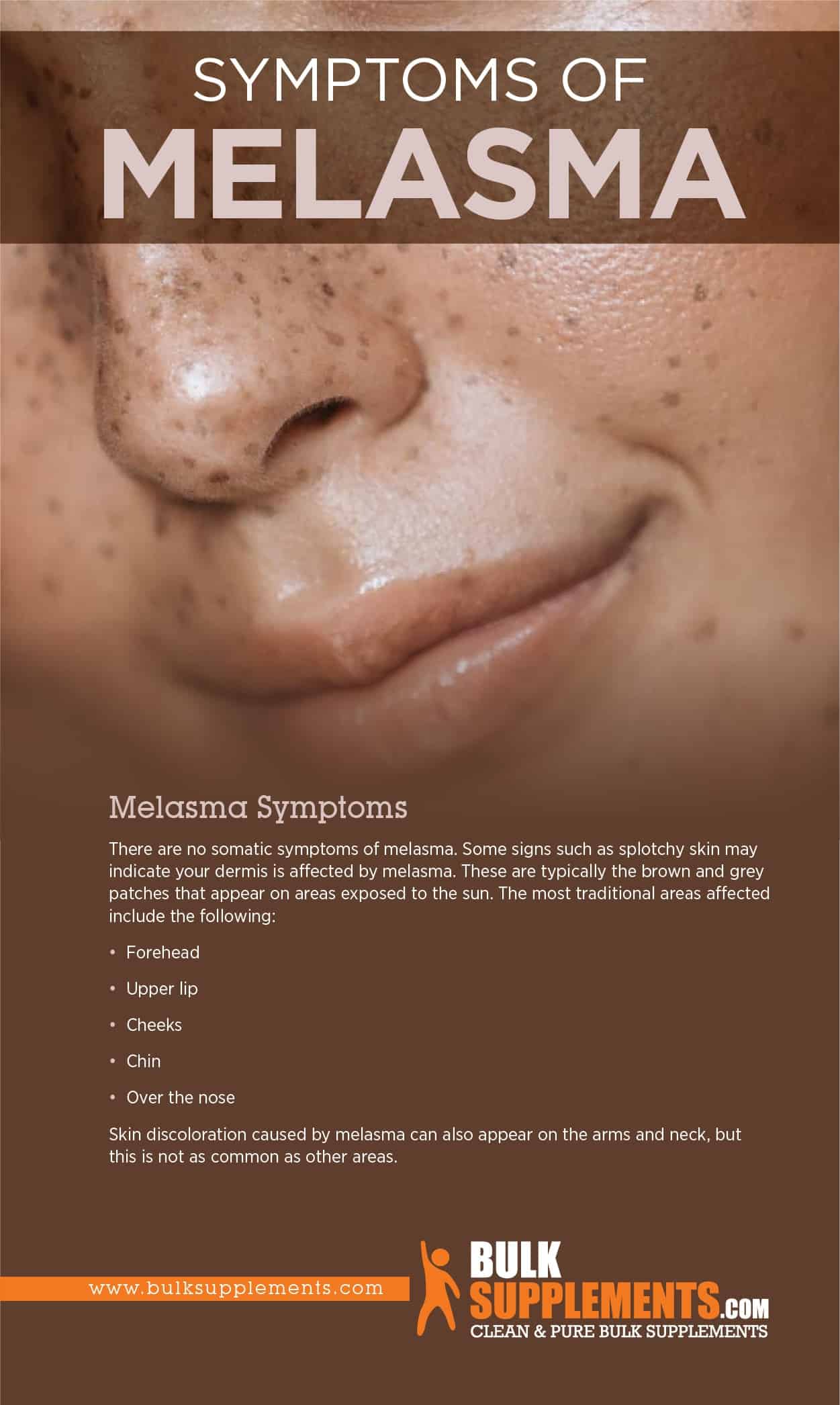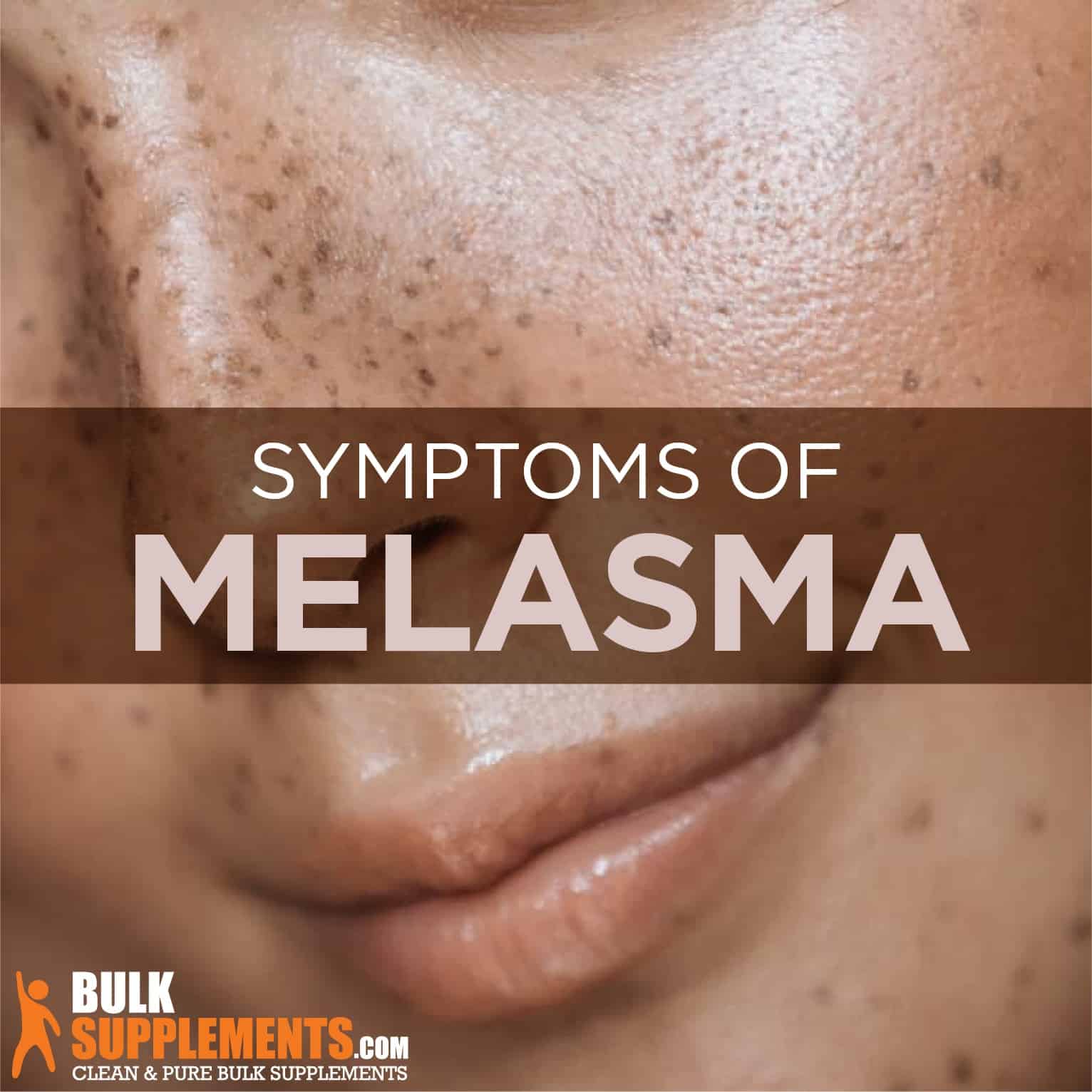What is Melasma?
Melasma is a common ailment that affects your skin. Many people mistake this condition with hyperpigmentation, but they are vastly different. This skin condition causes areas of your face to become discolored. In most patients with melasma, these brown and grey patches will appear on the cheeks, chin, nose, upper lip and forehead. In some cases, these patches may also manifest on your neck or forearms. Any place exposed to the sun on a regular basis increases its risk of developing these spots. Skin discoloration from melasma affects both genders, yet it is more common in women. On average, only 10 percent of those suffering from melasma are men. Aside from exposure to the sun, hormones can also trigger the condition. It is a predictable side effect of pregnancy, which dermatologists and OB-GYNs often call the health concern a “mask of pregnancy.” (x)
Melasma Symptoms
There are no somatic symptoms of melasma. Some signs, such as splotchy skin, may indicate melasma affects your dermis. These are typically the brown and grey patches that appear on areas exposed to the sun. The most traditional areas affected include the following: (x)
- Forehead
- Upper lip
- Cheeks
- Chin
- Over the nose
Skin discoloration caused by melasma can also appear on the arms and neck, but this is not as common as in other areas.
Melasma Causes
There is no specific cause for melasma. Most research links the condition as a result of melanocytes (darkens skin) creating too much melanin. People with tan and darker skin tones are more likely to develop melasma due solely to the concentration of active melanocytes. Several diverse factors can trigger melasma, such as: (x)
Sun Exposure
The UV light emitted by the sun stimulates the production of melanocytes in your skin. It only takes a limited amount of sun exposure to cause a noticeable flare-up. Most cases of melasma tend to worsen in the summer and reduce in the winter months. Because it only takes a minuscule amount of exposure to trigger a flare-up, you may suffer from chronic bouts of melasma. (x)
Hormonal Changes
Hormones occupy a leading role in how your body reacts to various triggers, medications and conditions. Pregnancy is when your body floods with copious amounts of hormones used to support a growing baby. These hormones can also cause melasma in pregnant women. Chloasma, also called a pregnancy mask, is reasonably common during pregnancy and usually resolves following birth. (x) (x)
Patients who are on various hormone replacement therapies or birth control may also develop melasma because of the increased concentration of critical hormones that trigger the condition.
Genetics
If you have family members or close relatives who suffer from melasma, there’s a greater chance for you to develop it as well. Those whose families tend to be sensitive to progesterone or estrogen are more prone to developing the condition. Melasma tends to be found more often among the following ethnicities: (x)
- Indian
- Latin/Hispanic
- African-American
- Asian
- Mediterranean
- Middle Eastern
- North African
Skin Care Treatments
Caring for your skin is an extraordinary way to keep it healthy, but sometimes the products can actually trigger melasma. Products that irritate your skin often cause melasma to develop or recur in patients with chronic melasma. (x)
How is Melasma Diagnosed?
It’s relatively simple to diagnose melasma. A dermatologist will complete a visual examination of your affected areas. In some cases, the dermatologist may request additional tests such as a biopsy in order to rule out other skin conditions. The most widely used test for melasma is the Wood’s lamp exam, (x) an assessment using a special light to identify any fungal or bacterial infections that may lurk on your dermis. A dermatologist can also find out how deep your melasma has penetrated. (x)
Melasma Remedies and Supplements
If you seek reliable ways to get rid of melasma, your treatment options will vary depending on what triggered the condition. Women suffering from the mask of pregnancy frequently see their conditions fade naturally once hormone levels adjust after birth.
Those who have triggered their condition because of hormone treatments will also typically notice a reduction of their melasma once treatment ends. If you’re uncomfortable with how melasma makes you look, your healthcare provider can refer you to support groups in your area. While there are treatments available for the condition, it’s important to keep in mind that they may not work the same for everyone. Some patients may see a recurrence following successful treatment.

Medical Treatments for Melasma
Gentle, non-invasive treatments are more preferable when addressing skin conditions; however, they’re not always successful. In the event that other methods fail, your dermatologist may suggest the following procedures: (x) (x) (x)
- Dermabrasion
- Chemical peel
- Microdermabrasion
- Laser treatment
- Dermal resurfacing
- Light therapy
These types of treatments embody their own unique risks. In some cases, they can cause new skin problems aside from melasma.
Supplements for Melasma
Some of the best melasma treatments available are natural. Nothing is better for your skin than nature itself. Be sure to consult your doctor before using any of them Some of the most effective supplements and natural remedies for the condition include these examples:
- Turmeric
Turmeric is an Asian herb used as a form of natural medicine for centuries. It’s an effective way to heal a range of skin conditions, including melasma. The curcumin in turmeric is a potent antioxidant that helps your body to boost cell regeneration. Create a topical application for melasma. You mix five spoons of turmeric and ten spoons of milk into a thick, sticky paste. Apply over the discolored areas and allow them to dry. Wash with lukewarm water. Habitual use may help to even skin tone and boost cell regeneration. The oral recommended dosage is 1,000 mg as a single dose once daily. The recommendation is to take the supplement with a meal and a glass of water. (x)
- Onion Juice
Onion juice may seem like an unlikely remedy for skin conditions, but it has proven effective restoring an even skin tone. The juice from an onion contains a high concentration of sulfur compounds. These compounds, such as cepaenes and sulfoxides, effectively target dark pigments in the skin. In addition to promoting an even skin tone, they help revive skin cells, which will give you a brighter complexion. (x)
- Hydroquinone
A dermatologist customarily uses hydroquinone as an initial treatment for melasma. It’s applied topically directly to the afflicted areas on the skin. It serves to help lighten dark spots and even skin tone. Hydroquinone gels and creams are available without a prescription, but a medical professional may prescribe more substantial concentrations. As with any skin-lightening product, it’s critical to use a sunscreen with a high SPF to protect from harmful UV rays. (x)
- Aloe Vera
Aloesin is a compound found in aloe vera that lightens areas of hyperpigmentation and melasma on the skin. Aloesin helps to lighten the skin by reducing the amount of melanin the body produces. When taken orally, aloe vera can reduce or prevent the mask of pregnancy. The recommended daily dosage is 1,000 mg consumed once daily with a full glass of liquid. As a topical agent, it can lighten, firm and moisturize the skin. You may use the gel obtained directly from a live plant or aloe vera powder that you reconstitute with water into a thin paste. (x) (x)
- Corticosteroids and Tretinoin Combined Creams
In severe cases, a single topical treatment may not produce noticeable results. In these instances, a dermatologist may consider a combination of topical cream as a viable treatment option. Combination creams traditionally consist of corticosteroids, tretinoin and hydroquinone in one treatment. They may also suggest treating the affected area with kojic acid or azelaic acids. These creams have often helped lighten skin, but they tend to accompany their own list of potential dangers. (x)
- Zinc
Hormone imbalances are one of the leading causes of hyperpigmentation and melasma. Supplementing with zinc can help break the cycle of imbalance and may reduce the signs of skin discoloration. Zinc is not only essential for healthy skin, but it also plays a vital role in metabolism. Zinc supplements help to filter out excessive amounts of these hormones and increase the efficiency of your thyroid. The recommended dose is no more than 90 mg per day. You should always take Zinc with a meal to prevent stomach upset. (x)
- Apple Cider Vinegar
Apple cider vinegar is one of the most versatile natural supplements on the market. It offers a diverse selection of benefits that may range from weight loss to smoking cessation. As a treatment for skin conditions, it can fight acne and possibly lighten dark patches. The acetic acid that occurs naturally in ACV works as a bleaching agent to lighten dark areas and help the skin form a healthier glow. ACV also has natural exfoliating properties, which can encourage skin cell regeneration. For topical use in the treatment of melasma, mix ACV and clean water in equal parts. With a clean cotton pad, apply to the affected areas twice daily. (x)
Where to Buy Supplements for Melasma Symptoms?
You can purchase these supplements to help with melasma symptoms at BulkSupplements.com. The company is an industry-leading manufacturer and distributor of pure dietary supplements.
BulkSupplements.com is not just a consumer brand. It also supplies pure ingredients to other food and supplement brands to make their products. All products at BulkSupplements.com are manufactured and tested according to current and proper manufacturing practices.
Are you interested in trying any of these supplements mentioned in this article as a possible solution to help you with melasma symptoms? Contact BulkSupplements.com to place an order today.
The Bottom Line
Melasma is a condition that affects millions of people worldwide. It’s painless and presents dermatological, socio-emotional and psychological challenges. The primary effect of melasma is self-esteem, since many patients become unhappy with the way their skin looks. Patients who enlist care from a competent dermatologist tend to achieve positive outcomes. Several medical and natural treatments may be effective in reducing the appearance of patchy or dark spots. Melasma has a variety of triggers, and the main one tends to be sun exposure. The condition can also be harder to treat in some patients. Regular treatments over the course of several weeks can result in an even skin tone or even a total elimination of melasma.
Medical treatments such as chemical peels and microdermabrasion are sometimes effective in reducing the appearance of dark spots and discoloration. Natural topical treatments such as ACV, turmeric, and vitamin C are also effective ways to manage melasma’s visual effects, hopefully. Following a regular regimen of skincare treatments prescribed by your dermatologist will also likely offer noticeable results. You can also follow a natural routine to produce visible improvement. Natural supplements such as zinc and vitamin C may help dispose of copper from the body while increasing the permeability of skin cells. When your cells are more receptive to topical treatments, removing dark spots, patchy areas, and other forms of skin discoloration is easier. You want to get the most benefit. It’s important not to skip any portion of your treatment.
Although treatment can help clear your melasma, most people typically require some form of maintenance therapy to keep it from recurring. Wearing sunscreen, avoiding direct sunlight and donning a hat when you go outside are practical measures.
These statements have not been evaluated by the Food and Drug Administration. These products are not intended to diagnose, treat, cure or prevent any disease.


